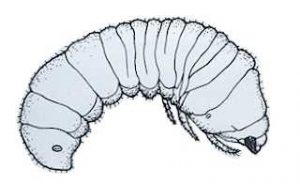Lyctus Powderpost Beetle – Lyctus brunneus
Next Beetle >>
Habitat
 General: Sapwood of tropical and European hardwoods, principally oak and elm, with large pores and high starch content. Not found in softwoods.
General: Sapwood of tropical and European hardwoods, principally oak and elm, with large pores and high starch content. Not found in softwoods.
Solid timber: Damage almost always originates in stockyard or storeroom infestation. Only found in timber containing adequate starch and usually with pores large enough for female beetles to lay eggs in. Common in furniture and occasionally in block or strip flooring.
Panel products: Veneers, plywood and blackboard are susceptible.
Damage Characteristics

Emergence holes: Circular, 1 – 2 mm diameter.
Tunnels: Circular, 1 – 2 mm diameter, random orientation but mostly parallel to grain. May be missed in initial stages of attack. In later stages sapwood almost completely disintegrates, leaving a thin, intact surface skin of wood.
Bore dust: Cream-coloured. Fine, talc-like when rubbed between fingers. May accumulate in small piles beneath emergence holes. Easily shaken out of tunnels.
Likely misidentifications: Common furniture beetle, Ptilinus beetle, pinhole borer beetle, bark borer beetle, Bostrychid powderpost beetle.
Remedial Treatments:
- Organic solvent or paste where sapwood is easily accessible.
- Treatment to furniture or flooring rarely justified on cost terms and often ineffective because finishes or mastic adhesives prevent uptake.
- Damage in old timber or furniture will probably be inactive and therefore not require treatment.
- Regular inspection of stored stock and kiln.
- Sterilisation of infested material necessary to prevent further recurrence.

Appearance
 Larva
Larva
Insect Characteristics and Location:
Adult: 4 – 7 mm long, reddish brown to black. Flattened and elongated with roughly parallel sides compared with rounded shape of common furniture beetle. Found on or around damaged timber, particularly during May to September but throughout the year in heated buildings.
Larvae : Up to 6 mm long, curved, pale cream. Three pairs of small legs. Light brown oval spots (breathing pores) on either side at rear of body. Found all year round in infested wood.
Next Beetle >>
